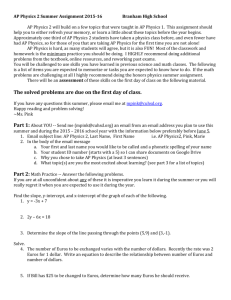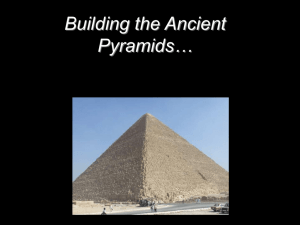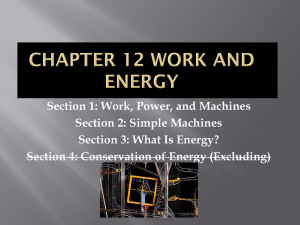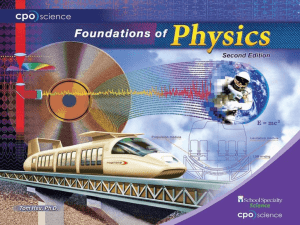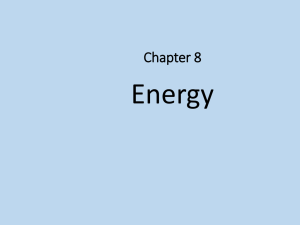Work, Energy, and Machines: Physics Presentation
advertisement
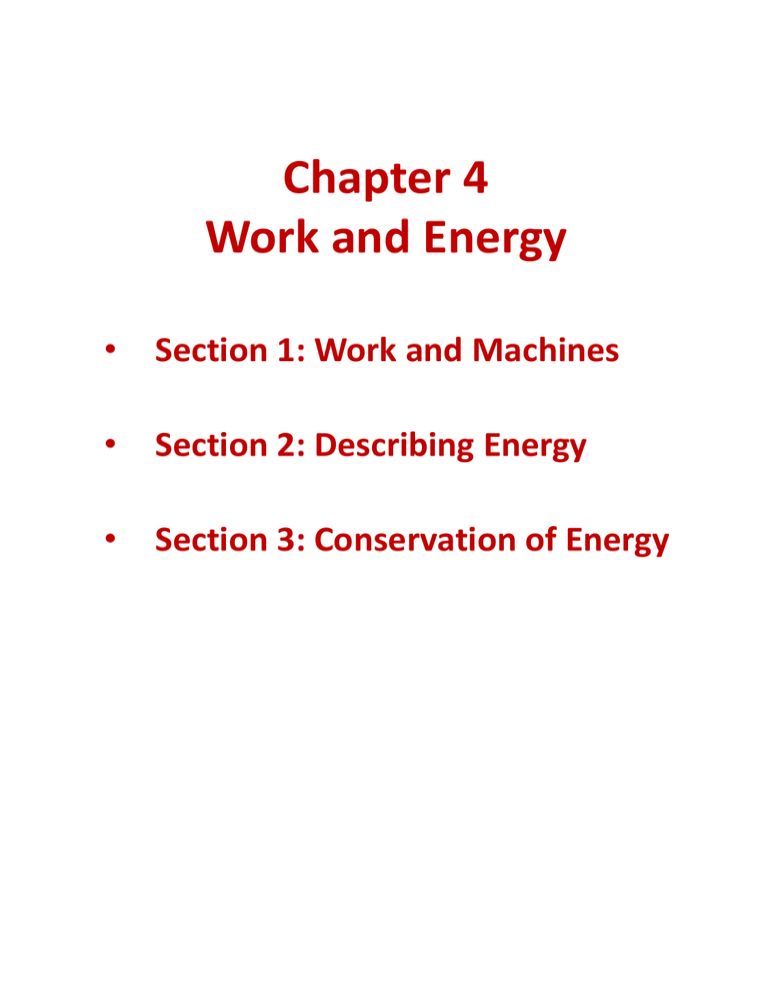
Chapter 4 Work and Energy • Section 1: Work and Machines • Section 2: Describing Energy • Section 3: Conservation of Energy Section 1: Work and Machines Work – the transfer of energy that occurs when a force makes an object move • no movement, no work • direction of the net force indicates where or on what work is being done • calculating work: equation for work: work = force x distance, or: 𝑾 = 𝑭𝒅 Where: Units for Work: W = Work F = force (N) d = distance (m) W =Fd W = (N)(m) = Nm 1Nm = 1 Joule (J) The unit for work is Joules (J) Example: How much work is done if Reggie lifts a box, m = 50kg, 1.75 meters? Solution: m = 50.0kg d = 1.75m Because Reggie is lifting the box he must exert a force greater than the weight of the box 𝑊 = 𝑚𝑔 𝑚 𝑊 = 50.0 𝑘𝑔 9.8 2 𝑠 𝑘𝑔𝑚 𝑊 = 490 2 = 490.0 𝑁 𝑠 Solve for work: 𝑊 = 𝐹𝑑 𝑊 = 490.0 𝑁 1.75𝑚 𝑊 = 857.5 𝑁𝑚 𝑾 = 𝟖𝟓𝟕. 𝟓 𝑱 Section 1: Work and Machines Machine – a device that makes doing work easier • Machines make doing work easier in three ways: 1. Increasing the force applied to the object example: a car jack to lift a car to change a flat tire 2. Increasing the distance over which the force is applied example: using a ramp to raise objects to a height 3. Changing the direction of the applied force example: a wedge – the vertical force is changed to a horizontal force • Work done by machines Two forces are involved when a machine is used to do work: 1. Effort force – the force applied to the machine 2. Resistance force – the force applied by the machine to overcome resistance • Conservation of Energy You transfer energy to a machine, the machine transfers that energy to the object Energy is neither created nor destroyed, so the work done by the machine is never greater than the work done to the machine Because of energy losses due to friction, the work done by the machine is always less than the work done to the machine Section 1: Work and Machines • Mechanical Advantage – the number of times a machine multiplies the effort force Equation for Mechanical Advantage : 𝑴𝑨 = 𝒇𝒐 𝒇𝒊 Where: MA = mechanical advantage fo = force out (force applied by the machine) fi = force in (force applied to the machine) Example: A claw hammer is used to pull a nail from a board. If the claw exerts a resistance force of 2500-N to the applied force of 125-N, what is the mechanical advantage of the hammer? Solution: fo = 2,500.0N 𝑓𝑜 𝑀𝐴 = fi = 125.0N 𝑓𝑖 MA =? 2,500𝑁 𝑀𝐴 = 125𝑁 𝑴𝑨 = 𝟐𝟎 Notice that the force units (N) cancel; mechanical advantage has no units, it is just a number. Section 1: Work and Machines Simple machine – a machine that does work with only one movement • There are six (6) simple machines divided into two types: The lever type The inclined plane type Includes: Lever Pulley Wheel and axle Includes: Ramp Wedge Screw Compound machine – a machine that consists of two or more simple machines used together Section 1: Work and Machines Lever – a bar that is free to pivot, or turn, about a fixed point. • There are three classes of levers: 1st class lever – the fulcrum is between the effort and the resistance Multiplies effort force and changes its direction Examples: crow bars, teeter-totters 2nd class lever – the resistance force is between the effort force and the fulcrum Multiplies force without changing direction Examples: wheel barrows, doors 3rd class lever – the effort force is between the fulcrum and the resistance force The effort force is always greater than the resistance force. MA < 1 Examples: the fore-arm, fishing poles If the 3rd class lever has no mechanical advantage, why use one? Section 1: Work and Machines Calculating the mechanical advantage of levers • Equation: 𝑴𝑨 = 𝒅𝒊𝒔𝒕𝒂𝒏𝒄𝒆 𝒐𝒇 𝒆𝒇𝒇𝒐𝒓𝒕 𝒂𝒓𝒎 , 𝒅𝒊𝒔𝒕𝒂𝒏𝒄𝒆 𝒐𝒇 𝒓𝒆𝒔𝒊𝒔𝒕𝒂𝒏𝒄𝒆 𝒂𝒓𝒎 or: 𝑴𝑨 = 𝒅𝒆 𝒅𝒓 the distances are measured from the fulcrum to the point where the forces are acting Example: If the distance of the effort force is 3-m, and the distance of the resistance arm is 1-m, what is the mechanical advantage of the lever? Solution: 𝑑𝑒 de = 3.0m 𝑀𝐴 = dr = 1.0m 𝑑𝑟 3.0𝑚 MA = ? 𝑀𝐴 = 1.0𝑚 𝑴𝑨 = 𝟑. 𝟎 Notice the distance units cancel. Remember, mechanical advantage is just a number. Section 1: Work and Machines Pulleys • The two sides of the pulley are the effort arm and the resistance arm. • A fixed pulley changes the direction of the force only, it does not increase force • A moveable pulley will increase the effort • Block-and-tackle – a system of pulleys consisting of fixed and moveable pulleys. The block-and-tackle will multiply the effort force Wheel-and-axle – a machine consisting of two wheels of different sizes that rotate together Inclined plane (ramp) – a sloping surface that reduces the amount of force required to do work • The same amount of work is done by lifting a box straight up or by sliding it up a ramp. However, the ramp reduces the amount of force required by increasing the distance Mechanical advantage of a ramp: 𝑴𝑨 = 𝒍𝒆𝒏𝒈𝒕𝒉 𝒐𝒇𝒊𝒏𝒄𝒍𝒊𝒏𝒆 , 𝒉𝒆𝒊𝒈𝒉𝒕 𝒐𝒇 𝒓𝒂𝒎𝒑 𝒍 or: 𝑴𝑨 = 𝒉 Example: Jessica uses a ramp 5-m long to raise a box to a height of 1-m. What is the mechanical advantage of the ramp? Solution 𝑙 Length =5.0m 𝑀𝐴 = Height = 1.0m ℎ 5.0𝑚 MA = ? 𝑀𝐴 = 1.0𝑚 𝑴𝑨 = 𝟓. 𝟎 Section 1: Work and Machines Screw – an inclined plane wrapped around a cylinder Wedge – an inclined plane with one or two sloping sides Mechanical Efficiency (ME) • Recall that the amount of work done by the machine (work output) is always less than the work done on the machine (work input) • Mechanical Efficiency is the measure of how much of the work put into a machine is changed into useful output work by the machine Because of friction no machine is 100% efficient. ME will always be less than 100% Equation: 𝑴𝑬 = 𝒘𝒐𝒓𝒌 𝒐𝒖𝒕𝒑𝒖𝒕 𝐱𝟏𝟎𝟎%, 𝒘𝒐𝒓𝒌 𝒊𝒏𝒑𝒖𝒕 or: 𝑴𝑬 = 𝒘𝒐 𝒙𝟏𝟎𝟎% 𝒘𝒊 Example: John is changing a flat tire on his truck. He does 2,500J of work on the jack, while the jack does 2,100J of work on the car. How efficient is the jack? Solution 𝑤𝑜 wi = 2,500J 𝑀𝐸 = 𝑥100% 𝑤 wo = 2,100J 𝑖 2,100𝐽 ME = ? 𝑀𝐸 = 𝑥100% 2,500𝐽 𝑀𝐸 = 0.84𝑥100% 𝑴𝑬 = 𝟖𝟒% Section 2: Describing Energy Energy – the ability to cause change • Energy comes in different forms chemical, electrical, thermal, etc. We will be looking at three (3) types of energy: kinetic, potential, and mechanical. • Kinetic Energy (KE) KE is energy in a moving object Anything that moves has kinetic energy Kinetic energy depends of two things: 1. the mass of the moving object 2. the velocity of at which the object is moving Equation for kinetic energy: 𝟏 Where: 𝑲𝑬 = 𝒎𝒗𝟐 KE = kinetic energy 𝟐 M = mass (kg) V = velocity (m/s) Unit for energy: 𝑚 𝐾𝐸 = 𝑘𝑔( )2 𝑠 2 𝑚 𝐾𝐸 = 𝑘𝑔 2 𝑠 kgm2 𝐊𝐄 = = Nm = 𝐉 s2 Section 2: Describing Energy Example: A ball, m = 1.5-kg, is rolling across the floor towards the door at 2 m/s. What is the KE of the rolling ball? Solution m = 1.5-kg v = 2.0-m/s KE = ? 1 𝐾𝐸 = 𝑚𝑣 2 2 1 𝑚 2 𝐾𝐸 = ( )(1.5𝑘𝑔)(2.0 ) 2 𝑠 1 𝑚2 𝐾𝐸 = 1.5𝑘𝑔 4.0 2 2 𝑠 𝒌𝒈𝒎𝟐 𝑲𝑬 = 𝟑. 𝟎 = 𝟑. 𝟎 𝑱 𝒔𝟐 Important: Always square the velocity before you do any multiplication • Potential Energy Potential energy – energy stored due to an object’s position Three types of potential energy: Elastic – PE stored by things that stretch or compress Ex.: rubber bands, springs, pole vault poles Chemical – PE stored in chemicals bonds Ex.: nuclear weapons and fuels Gravitational – PE stored by things that are elevated Ex.: fruit on trees, bouncing balls Section 2: Describing Energy • The amount of potential energy can be determined mathematically. We will focus on gravitational PE Equation for gravitational PE: PE = Potential Energy (J) 𝑷𝑬 = 𝒎𝒈𝒉 M = mass (kg) g = 9.8 m/s2 H = height (m) Example: An apple, mass = 0.5-kg, is hanging from a branch 4.0-m above the ground. What is its gravitational PE? Solution m = 0.5 kg 𝑃𝐸 = 𝑚𝑔ℎ 𝑚 h = 4.0 m 𝑃𝐸 = 0.5𝑘𝑔 9.8 2 4.0𝑚 𝑠 PE = ? 2 𝑘𝑔𝑚 𝑃𝐸 = 19.6 2 𝑠 𝑷𝑬 = 𝟏𝟗, 𝟔 𝑱 Section 3: Conservation of Energy • Mechanical Energy – the total amount of potential and kinetic energy in a system Equation: mechanical energy = potential energy + kinetic energy, or: M E = P E + K E Example: An object held in the air has a gravitational PE of 480.0J. What is its kinetic energy if it has fallen two-thirds of the way to the ground? Solution a)Before the object started falling ME = PE, so ME = 480.0J. b)As the object is falling PE is being converted to KE. c)At anytime during the fall ME = PE + KE. d)When the object is two-thirds of the way down ME = 1/3PE + 2/3KE. e)So: KE = 2/3(480.0 J), or KE = 320.0J • Law of Conservation of Energy: Energy is neither created nor destroyed On a large scale: total energy in the universe is constant Consequence: energy can change form: potential kinetic kinetic thermal chemical mechanical Section 3: Conservation of Energy • Power – the amount of work done in a certain amount of time Power is a rate Equation for calculating power: Units for Power: the Watt (W) pow er = w o rk ,or : P = tim e 1W = 1 J = 1 W t kg m 2 s3 s 1 watt is about equal to the power required to lift a glass of water from a table to your mouth Example 1: It took 20 seconds to move a refrigerator, You did 3,150 J of work in the process. How much power was required to move the refrigerator? Solution P = W t P = 3 ,1 5 0 J 20s P = 1 5 7 .5 J = 1 5 7 .5 W s Example 2: It took you 1.5 s to lift a 10-kg box of the floor to a height of 1.0-m. How much work did you do on the box, and how much power was required to do this? Solution t = 1 .5 s m = 1 0 .0 k g F = W (e ig h t) = m g F = 1 0 k g (9 .8 d = 1 .0 m W = ? P = ? F = 98 kg m s2 m s2 ) W = Fxd W = 9 8 N (1 .0 m ) W = 98N m = 98J = 98N P = W t P = 98J 1 .5 s P = 6 5 .3 3 J s = 6 5 .3 3 W




